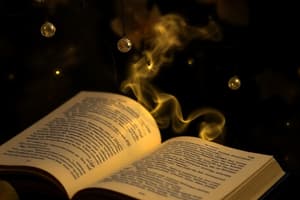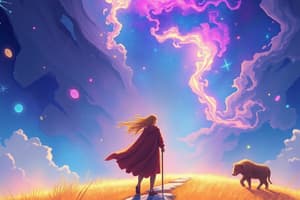Podcast
Questions and Answers
What is the theme of a poem?
What is the theme of a poem?
The theme is the controlling idea or the poet's feeling about a particular subject.
What was the initial interpretation of Shakespeare's Sonnet 130?
What was the initial interpretation of Shakespeare's Sonnet 130?
The speaker praises the woman he loves despite her not fitting traditional ideals of beauty.
What is a clear theme expressed in Shakespeare's Sonnet 130?
What is a clear theme expressed in Shakespeare's Sonnet 130?
The theme is that the speaker loves the woman even though she does not represent the idealized beauty.
What theme is noted from Robert Frost's 'Stopping by Woods on a Snowy Evening'?
What theme is noted from Robert Frost's 'Stopping by Woods on a Snowy Evening'?
How does the speaker's horse in 'Stopping by Woods on a Snowy Evening' contribute to the themes?
How does the speaker's horse in 'Stopping by Woods on a Snowy Evening' contribute to the themes?
What is the role of figurative language in poetry?
What is the role of figurative language in poetry?
What does imagery refer to in poetry?
What does imagery refer to in poetry?
What is the purpose of repetition in poetry?
What is the purpose of repetition in poetry?
What does symbolism represent in poetry?
What does symbolism represent in poetry?
What is the main theme explored in Rabindranath Tagore's 'We Both Live in the Same Village'?
What is the main theme explored in Rabindranath Tagore's 'We Both Live in the Same Village'?
How does 'A Poem of Changgan' depict the changing emotions of the speaker?
How does 'A Poem of Changgan' depict the changing emotions of the speaker?
What emotional desire does the speaker express at the end of 'A Poem of Changgan'?
What emotional desire does the speaker express at the end of 'A Poem of Changgan'?
Flashcards are hidden until you start studying
Study Notes
Understanding Theme in Poetry
- Themes represent the poet's perspective and feelings about a subject.
- The same subject can yield different themes across various poems, such as love or nature.
- A distinguishing example is Shakespeare's Sonnet 130, where the subject is beauty but the theme critiques traditional love ideals.
Analysis of "Stopping by Woods on a Snowy Evening"
- This poem's subject involves a speaker admiring the beauty of snow-covered woods.
- The theme highlights nature's allure versus human responsibilities, emphasizing individual experience.
- The speaker’s connection to nature contrasts with the horse's instinctual urge to return home, signifying a tension between desire and duty.
Figurative Language in Poetry
- Poets rely heavily on figurative language to express complex ideas and emotions.
- This language includes imagery, repetition, and symbolism, enriching the thematic depth of poems.
Imagery
- Imagery creates vivid mental pictures, appealing to the senses, as displayed in John Keats's "To Autumn."
- Keats evokes nature's beauty using descriptive language that paints a sensory experience.
Repetition
- Repetition emphasizes key ideas, creates rhythmic patterns, and enhances emotional impact, evident in Emily Dickinson's "I'm Nobody! Who Are You?"
- Edgar Allan Poe uses repetition to mimic the sound of bells, enhancing auditory imagery in "The Bells."
Symbolism
- Symbolism uses objects or concepts to represent deeper meanings, like seasons representing different life stages (e.g., winter for death).
- Shakespeare employs seasonal imagery in Sonnet 97 to express feelings of absence and longing.
The Use of Figurative Elements in “Stopping by Woods on a Snowy Evening”
- The imagery of a rider in dark woods creates a lasting visual impression.
- Sounds from the scene, like harness bells, enhance realism and remind the speaker of life's duties.
- Darkness symbolizes the unknown, while the repeated phrase "And miles to go before I sleep" signifies an acceptance of life’s responsibilities.
Rabindranath Tagore and His Background
- Tagore was a pivotal Indian poet, born in 1861, recognized for blending rich cultural themes into poetry.
- He rejected formal schooling, instead gained knowledge through family influence and experience abroad.
- Nobel laureate in 1913 and known for his contributions to literature, music, and art.
Tagore's Romantic Poetic Style
- Tagore's poetry features simple natural imagery and reflects on themes of love while influencing many writers globally.
- The poem "We Both Live in the Same Village" showcases his use of symbolism and connection to love and nature.
Overview of "A Poem of Changgan" by Li Po
- Li Po, a significant Chinese poet, created immersive narratives reflecting his romantic ideals and connection with nature.
- The poem's structure allows the exploration of a wife's evolving love for her husband over time.
- The narrative transitions from childhood innocence to mature love, conveying complex emotions of separation.
Emotional Evolution in "A Poem of Changgan"
- The speaker recalls childhood memories with her husband, illustrating a deepening bond through vivid imagery.
- Repetition of phrases underscores the emotional weight of absence and longing as seasons pass.
- The desire to reunite highlights an intense yearning, contrasting the joyful expressions in Tagore's poetry.
Studying That Suits You
Use AI to generate personalized quizzes and flashcards to suit your learning preferences.




